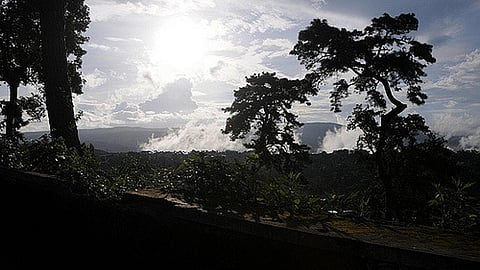
- Topics
- Feature
- Opportunities & Events
- About
- Hindi Portal
- Data
- Topics
- Feature
- Opportunities & Events
- About
- Hindi Portal
- Data

Sitting in the glass-and-concrete State Convention Centre in the capital of the hilly state of Meghalaya, participants of a media workshop on climate change are feeling sweaty. The convention centre is not air conditioned nor does it have ceiling fans. For the comfort of guests, some pedestal fans are plugged in.
“Why are we sweating in Shillong?” asks state information technology minister Dr M. Ampareen Lyngdoh. The question may sound strange for those who have read in tourist brochures and textbooks about Meghalaya having the wettest place on the planet and about its round-the-year cool weather.
A new study done by researchers from the Water and Climate Lab at Indian Institute of Technology (IIT), Gandhinagar has come up with the answer to the question. The study has shown that air temperature in the state is rising at the rate of 0.031 degree per year. The trend is consistent from 1981 to 2014, barring the years 1991 and 1992. This translates to one-degree centigrade rise between 1981 and 2014, which is quite significant. Future projections indicate similar rise over the next two decades.
The state has also been witnessing highly fluctuating frequencies of hot and cold days and nights. “The number of hot days and nights show an increase while that of cold days and cold nights show a decrease. These are indications of a consistently warming region,” says the lead author of the study Dr Vimal Mishra while presenting the study results. “The higher number of hot nights is a matter of concern for the state.”
Based on historic and observed data as well as computer models, the study has projected changes over short-term (2013-2040), mid-term (2041-2070) and long-term (2071-2100) for the state. It is a high-resolution study in the sense that projections have been made for grids of 5X5 km size, so as to help in the vulnerability assessment for each grid and adaptation planning at local level.
Future projections show temperature rise under different scenarios--the rise in maximum temperature in Meghalaya in the long term ranges from 2.65 degrees to 3.8 degrees while the rise in minimum temperature will be between 2 degrees and 3.5 degrees in the long term. The increase in temperature may result in higher number of hot days and nights. Under the extreme scenario projection, the number of hot days could be as high as 100 a year. Similarly, there may be a decrease in cold days and nights.
“The state has already seen a rise in temperature of 1 to 1.5 degree in the past three decades and the projections point to a similar rise by 2040. If the temperature in Meghalaya rises by about 3 degrees in a span of half a century, we don’t know what Meghalaya will be like in the future. West Bengal or Assam?,” wonders Dr Mishra.
In the future, there will be changes in the rainfall patterns, too. The central plateau region is projected to experience an increase in rainfall at a higher rate than the rest of the state. The occurrence of extreme rainfall events will also show an upward trend under various projected scenarios. “The West Khasi hills which already receive very high precipitation are projected to face an even higher rise in precipitation,” Dr Mishra says.
The changing climate in Meghalaya, he says, would have widespread implications on forests, water resources, biodiversity, agriculture, livestock and human health. For instance, due to a significant rise in temperature, forest fires may go up while extreme rainfall events will increase the risk of landslides in high altitude areas causing siltation of water bodies downstream. The rise in temperature will also threaten endemic plant species many of which are already on the verge of extinction. Rainfed agriculture in the state will be adversely hit with crop yields and production declining. Higher temperature will also induce premature breaking of insects and pests.
“Meghalaya has some of the most vulnerable districts to current climate risks and long-term climate change in the region,” points out Prof. N.H. Ravindranath of Indian Institute of Science, Bangalore. “Sectors like agriculture, forests, fisheries, horticulture are already been subjected to high climate risks currently and will be highly vulnerable to climate change risks in the future. We need to prepare both incremental as well as transformational adaptation plans based on vulnerability assessments.”
The workshop was organised jointly by the Department of Science and Technology, Indian Himalayas Climate Adaptation Programme (IHCAP) and Centre for Media Studies. (India Science Wire)